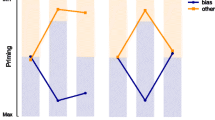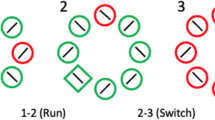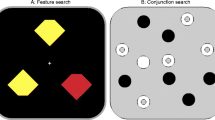Abstract
Current theories of the locus of inter-trial priming effects in efficient visual search posit an early perceptual component that reflects the short-term influence of a memory trace for low-level stimulus attributes. Despite the fact that this memory trace is hypothesized to be short term, and should therefore have a diminishing influence on performance over time, there has been relatively little study of the effect of time alone on singleton priming effects. The present series of experiments addresses this issue by systematically examining the effect of time on the priming of pop-out (PoP) effect. In Experiment 1, we show that the PoP effect does indeed diminish with increases in the RSI between trials, and does so in accord with a power-law function. In Experiment 2, we show that temporal discriminability of trial n − 1 from the trial that precedes it does not contribute to PoP effects. The results of Experiment 3 revealed two key results: (1) the PoP effect survives an equivalent number of intervening trials across very different RSI conditions; and (2) the cumulative target repetition benefit does depend on the RSI between trials. Together, the results favor neither a simple passive decay nor a strong episodic retrieval account of the PoP effect.










Similar content being viewed by others
Notes
The slower RTs overall at the 500 and 16,000 RSI conditions likely owe to lack of preparation on the part of the observers either because there is insufficient preparatory time (i.e. the 500 ms RSI condition) or because participants become distracted at particularly long RSIs (i.e. the 16,000 ms RSI condition), despite the fact that the fixation cross signaled an upcoming search trial 500 ms prior to its presentation. Although it might be argued that the especially large PoP effects that accompany slower responding at the shortest RSI may in some way produce the profound influence of RSI on PoP at these shorter RSIs, mean RTs are also slower at the longest RSI; the condition with the smallest PoP effect.
References
Asgeirsson, A. G., & Kristjansson, A. (2011). Episodic retrieval and feature facilitation in intertrial priming of visual search. Attention, Perception & Psychophysics, 73(5), 1350–1360.
Atkinson, R. C., & Shiffrin, R. M. (1968). Human memory: A proposed system and its control processes. In K. W. Spence & J. T. Spence (Eds.), The psychology of learning and motivation (Vol. 2, pp. 89–195). New York: Academic Press.
Brascamp, J. W., Pels, E., & Kristjansson, A. (2011). Priming of pop-out on multiple time scales during visual search. Vision Research, 51(17), 1972–1978.
Bravo, M., & Nakayama, K. (1992). The role of attention in different visual search tasks. Perception & Psychophysics, 51, 465–472.
Brown, G. D. A., Neath, I., & Chater, N. (2007). A temporal ratio model of memory. Psychological Review, 114(3), 539–576.
Cousineau, D. (2005). Confidence intervals in within-subjects designs: A simpler solution to Loftus and Masson’s method. Tutorials in Quantitative Methods in Psychology, 1, 42–45.
Hillstrom, A. P. (2000). Repetition effects in visual search. Perception & Psychophysics, 62(4), 800–817.
Hommel, B. (1998). Event files: Evidence for automatic integration of stimulus-response episodes. Visual Cognition, 5(12), 183–216.
Hommel, B. (2004). Event files: Feature binding in and across perception and action. Trends in Cognitive Sciences, 8(11), 494–500.
Howard, M. W., & Kahana, M. J. (2002). A distributed representation of temporal context. Journal of Mathematical Psychology, 46, 269–299.
Huang, L., Holcombe, A. O., & Pashler, H. (2004). Repetition priming in visual search: Episodic retrieval, not feature priming. Memory & Cognition, 32(1), 12–20.
Kahneman, D., Treisman, A., & Gibbs, B. (1992). The reviewing of object files: Object-specific integration of information. Cognitive Psychology, 24, 175–219.
Kristjansson, A., & Campana, G. (2010). Where perception meets memory: A review of repetition priming in visual search tasks. Attention, Perception & Psychophysics, 72, 5–18.
Kristjansson, A., Ingvarsdottir, A., & Teitsdottir, U. D. (2008). Object and feature-based priming in visual search. Psychonomic Bulletin & Review, 15(2), 378–384.
Lamy, D., Yashar, A., & Ruderman, L. (2010). A dual-stage account of inter-trial priming effects. Vision Research, 50, 1396–1401.
Lamy, D., Zivony, A., & Yashar, A. (2011). The role of search difficulty in intertrial feature priming. Vision Research, 51, 2099–2109.
Lee, H., Mozer, M. C., & Vecera, S. P. (2009). Mechanisms of priming of pop-out: stored representations or feature-gain modulations? Attention, Perception, & Psychophysics, 71(5), 1059–1071.
Logan, G. D. (1988). Toward an instance theory of automatization. Psychological Review, 95(4), 492–527.
Logan, G. D. (1990). Repetition priming and automaticity: Common underlying mechanisms? Cognitive Psychology, 22, 1–35.
Malkjovic, V., & Nakayama, K. (1994). Priming of pop-out: I. Role of features. Memory & Cognition, 22(6), 657–672.
Malkjovic, V., & Nakayama, K. (1996). Priming of pop-out: II. The role of position. Perception & Psychophysics, 58(7), 977–991.
Malkjovic, V., & Nakayama, K. (2000). Priming of pop-out: III. A short-term implicit memory system beneficial for rapid target selection. Visual Cognition, 7(5), 571–595.
Martini, P. (2010). System identification in priming of pop-out. Vision Research, 50, 2110–2115.
McCarley, J. S., Kramer, A., Colcombe, A. M., & Scialfa, C. T. (2004). Priming of pop-out in visual search: A comparison of young and old adults. Neuropsychology and Cognition, 11(1), 80–88.
McPeek, R. M., Maljkovic, V., & Nakayama, K. (1999). Saccades require focal attention and are facilitated by a short-term memory system. Vision Research, 39, 1555–1566.
Neill, W. T., Valdes, L. A., Terry, K. M., & Gorfein, D. S. (1992). The persistence of negative priming: evidence for episodic trace retrieval. Journal of Experimental Psychology. Learning, Memory, and Cognition, 18(5), 993–1000.
Thomson, D. R., & Milliken, B. (2012). Perceptual distinctiveness produces long-lasting priming of pop-out. Psychonomic Bulletin & Review, 19(2), 170–176.
Thomson, D.R., & Milliken, B. (in press). Contextual distinctiveness produces long-lasting priming of pop-out. Journal of Experimental Psychology: Human Perception and Performance
Turvey, M. T., Brick, P., & Osborn, J. (1970). Proactive interference in short-term memory as a function of prior-item retention interval. Quarterly Journal of Experimental Psychology, 22(2), 142–147.
Van Selst, M., & Jolicoeur, P. (1994). A solution to the effect of sample size on outlier elimination. The Quarterly Journal of Experimental Psychology, 47(3), 631–650.
Wolfe, J. M. (1994). Guided search 2.0: A revised model of visual search. Psychonomic Bulletin & Review, 1(2), 202–238.
Wolfe, J. M., Butcher, S. J., Lee, C., & Hyle, M. (2003). Changing your mind: On the Contributions of top-down and bottom-up guidance in visual search for feature singletons. Journal of Experimental Psychology: Human Perception and Performance, 29, 483–502.
Wolfe, J. M., Cave, K. R., & Franzel, S. L. (1989). Guided search: An alternative to the feature integration model for visual search. Journal of Experimental Psychology: Human Perception and Performance, 15(3), 419–433.
Yashar, A., & Lamy, D. (2011). Refining the dual-stage account of intertrial feature priming: Does motor response or response feature matter? Attention, Perception & Psychophysics, 73(7), 2160–2167.
Acknowledgments
This work was supported by an NSERC Discovery Grant awarded to B.M. In addition we would like to thank two anonymous reviewers for their helpful comments on an earlier version of this manuscript. We would also like to thank Maria C. D’Angelo.
Author information
Authors and Affiliations
Corresponding author
Rights and permissions
About this article
Cite this article
Thomson, D.R., Milliken, B. Revisiting the time course of inter-trial feature priming in singleton search. Psychological Research 77, 637–650 (2013). https://doi.org/10.1007/s00426-012-0455-7
Received:
Accepted:
Published:
Issue Date:
DOI: https://doi.org/10.1007/s00426-012-0455-7




